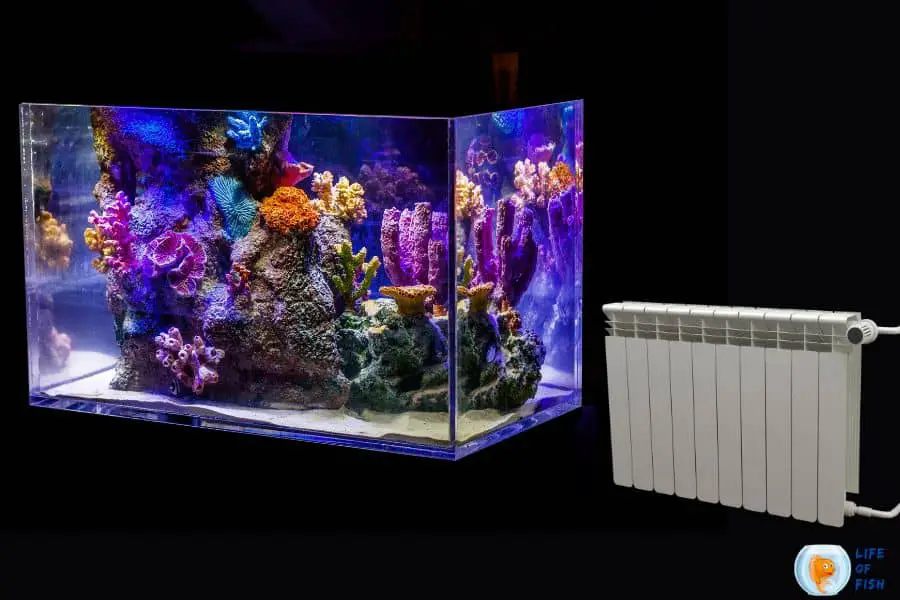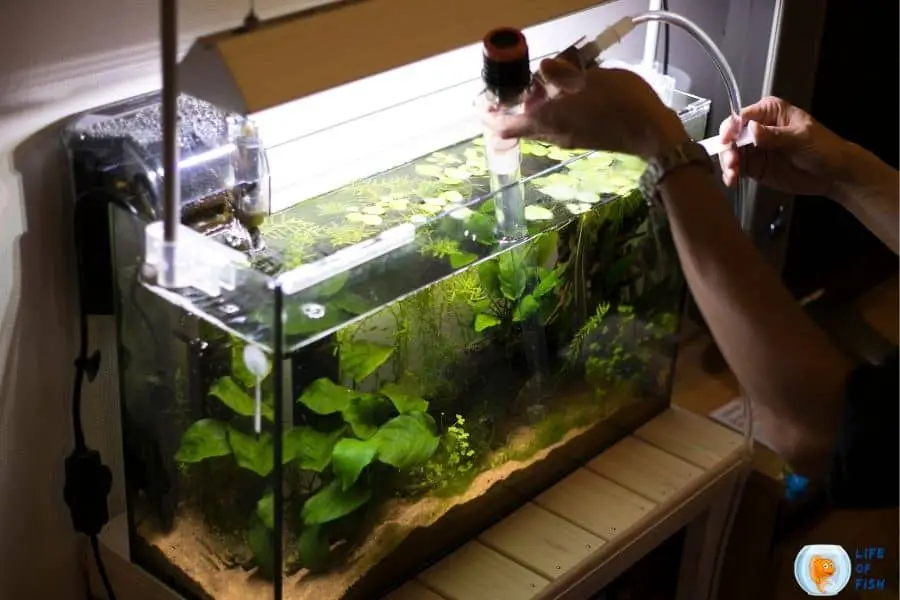Can You Put A Fish Tank Near A Radiator? It may seem like a great idea to keep your aquarium close to a source of warmth, but in reality, this will cause significant issues with oxygen levels.
Ensure you never place an animal next door or under any radiators as they can easily overheat and die.

A fish tank is not something you can keep anywhere you want. It contains living beings. Hence it needs to be in a safe and sound place.
There are many factors that need to be considered before putting a fish tank in your house. One of them is the radiator. It can be either electric or water-filled.
If you absolutely must put your fish tank near a radiator, then there are a few things you can do to ensure that your fish are safe.
This article will discuss how temperature fluctuations affect fish, the ideal water temperatures, and how you can keep your fish safe by providing ideal temperature levels (even near a radiator).
How does a radiator work in a house?
Jump To
- 1 How does a radiator work in a house?
- 2 How does a radiator affect a fish tank?
- 3 Can fish survive with temperature fluctuations?
- 4 Ideal water temperature for fish
- 5 How does water temperature affect fish?
- 6 How to maintain stable water temperature
- 7 How to control the aquarium temperature near the radiator?
- 8 Conclusion
Electric radiators work by heating up a metal element inside the radiator. This element then emits infrared radiation, which is absorbed by objects in the room, and this is what heats the room up.
Water-filled radiators work by taking water from the central heating system and circulating it around the radiator. The water gives off heat as it circulates, and this heats up the room.
So, in general, a radiator is a heat source. And as we all know, heat and fish don’t mix well.
How does a radiator affect a fish tank?
When the radiator is turned on, the objects in the surrounding area heat up. This includes the fish tank.
When the water in the aquarium is heated up, the oxygen levels in the water start to decrease. The warmer the water, the less oxygen water can hold.
While most fish can survive temperature fluctuations, they can not do so when the temperature rises in a short period of time. Radiators can increase the fish tank temperature within minutes, and this can cause the oxygen levels in the water to drop significantly.
When the oxygen levels in the water drop, the fish start to suffocate. They start to gasp for air and swim erratically. If the oxygen levels drop too low, the fish will die.
Can fish survive with temperature fluctuations?
As we mentioned above, fish can survive with temperature fluctuations. This is because the climate in the wild doesn’t stay the same as it is in captivity.
The water temperature in the wild can rise and fall depending on the season. Usually, these temperature changes happen slowly over a period of time, so the fish have time to adjust.
Further, the temperature in the wild water doesn’t change so fast because of the high quantity of water. It takes much time to circulate the temperature in ponds, rivers, lakes, and oceans.
In contrast, the temperature in a fish tank can change very quickly because of the small quantity of water.
What fish can not survive is a sudden temperature change. When the water temperature rises or falls too quickly, it can cause shock to the fish. In extreme situations, it could even be fatal.

Ideal water temperature for fish
The ideal water temperature of fish can change depending on the species. Some fish can live in both cold and warm water, while others can only live in one or the other.
For example, tropical fish need warm water to survive. The ideal water temperature for them is between 24-28 degrees Celsius.
On the other hand, goldfish can live in both cold and warm water. The ideal water temperature for them is between 18-22 degrees Celsius.
Cold water fish like tetras and barbs can not survive in warm water. They need temperatures of 10-24 degrees Celsius to survive.
So, as you see, the ideal water temperature for fish can change depending on the species.
How does water temperature affect fish?
Fish are cold-blooded creatures. This means that their body temperature change depending on the water temperature.
Their metabolism slows down when the water is cold, and they become less active. When the water is warm, their metabolism speeds up, and they become more active.
While most fish can survive in a wide range of temperatures, there is a limit to how much they can take. If the water temperature drops or rises too much, it can cause shock to the fish. In some cases, it can even be fatal.
Sudden temperature changes can cause stress in fish. Every fish owner knows that stress can cause various health problems in fish.
It can even lead to death. Other than stress, water temperature affects fish in a variety of ways.
Warm Water
When the water is warm, the fish become more active. This is because their metabolism speeds up. As a result, they need more oxygen to survive.
But, the percentage of dissolved oxygen in water decreases as the water temperature increases.
This means that there is less oxygen available for the fish to breathe. When the oxygen levels in the water start to drop, the fish start to suffocate.
To make things worse, the warmer the water, the less oxygen it can hold. This is because warm water is less dense than cold water.
As a result, the fish start to gasp for air and swim erratically. If the oxygen levels drop too low, the fish will die.
Cold Water
When the water gets colder, the fish become less active. This is because their metabolism slows down. As a result, they need less oxygen to survive.
Due to the changes in their metabolism, fish reduce their feedings and eventually stop eating altogether. When the fish stop eating, they start to lose weight. In extreme cases, the fish can even die from starvation.
Water temperature also affects the fish’s immune system. When the water is cold, the fish’s immune system becomes weaker. This makes them more susceptible to diseases and parasites.

How to maintain stable water temperature
Now that you know how important water temperature is for fish, you’re probably wondering how to maintain a stable water temperature. The good news is you can do a few things to keep the water temperature stable.
Use an aquarium heater
If you have a tropical fish tank, then you’ll need to use an aquarium heater to maintain the water temperature. Aquarium heaters are designed to keep the water at a constant temperature.
You can find aquarium heaters at your local pet store or online. When choosing an aquarium heater, make sure to get one that fits your fish tank size.
Use an aquarium thermometer
To make sure that the water temperature stays constant, you’ll need to use an aquarium thermometer. Aquarium thermometers are designed to measure the water temperature.
You can find aquarium thermometers at your local pet store or online.
Use an aquarium chiller
If you have a cold-water fish tank and live in a cold area, then you’ll need to use an aquarium chiller to maintain the water temperature. Aquarium chillers are designed to keep the water at a constant temperature.
You can find aquarium chillers at your local pet store or online. When choosing an aquarium chiller, make sure to get one that fits your fish tank size.
Change the water regularly
Another way to maintain a stable water temperature is to change the water regularly. This will help to remove any toxins or impurities that can cause the water temperature to fluctuate.
How to control the aquarium temperature near the radiator?
Sometimes, you will have no choice other than to keep your fish tank near the radiator. In this case, you will need to take some extra steps to make sure that the water temperature stays stable.
Use an automatic aquarium temperature controller
The first thing you’ll need to do is to get an automatic aquarium temperature controller. Automatic aquarium temperature controllers are designed to keep the water at a constant temperature.
These smart aquarium equipment help keep stable temperatures in your fish tank by heating the water when it is cold and cooling down the tank when it is too warm.
Basically, this equipment has three components.
- A heater
- a chiller and
- a thermometer
You can select ideal temperature settings, and the equipment will do the rest. The only thing you need to do is to monitor the temperature readings from time to time.
Use a fan
While this may sound a stupid idea, it is really an effective way of controlling the aquarium temperature near the radiator.
All you need to do is to place a fan near the fish tank. The moving air will help to regulate the water temperature.
You can use a regular fan or an oscillating fan. Just ensure the fan is not blowing directly onto the fish tank.
Conclusion
Can You Put A Fish Tank Near A Radiator? No. You can not, and you should not. If you keep your fish tank near a radiator, your fish will suffocate because of the warmer temperature and may die.
However, there are things you can do to overcome this problem. You can use an automatic aquarium temperature controller or a fan to stabilize the water temperature. Just make sure to monitor the water temperature from time to time so that you can assure that your fish are safe.
Read next : How Far From Wall Should The Fish Tank Be ? (Answer Is Here)
